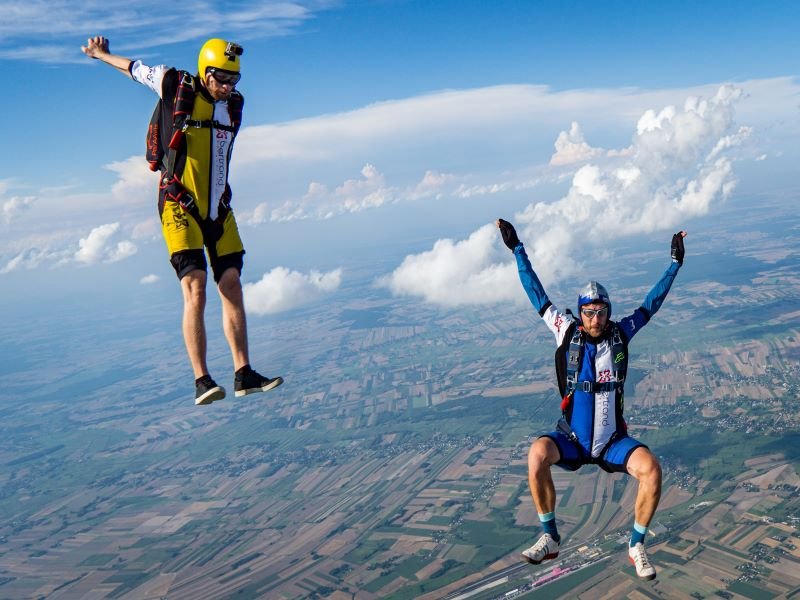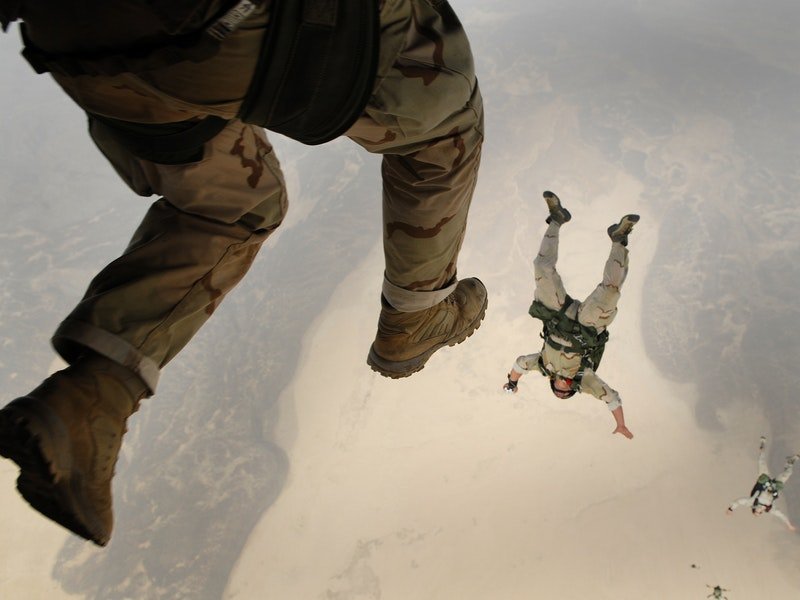If you’ve never skydived before, you are probably wondering how long the average skydive takes. Does it take all day to prepare, get up in the sky, and make your first jump? Or can you make multiple dives on your first day?
A lot will depend on your experience and whether you are doing a tandem or solo dive. And you also have to bear the weather in mind; skydiving relies heavily on those beautiful clear blue skies.
Let’s break it down and take a look at how long an average day of skydiving will take. We can look at preparation time and how long you will actually be diving. We can also look at the difference between solo and tandem skydiving. And look at how many skydives you can make in a single day.
How long does it take to prepare for a skydive?

Let’s assume you’ve already done your basic training and you are turning up for one of your first skydives. Let’s also assume you are jumping in a small group of 3-4 skydivers. Here’s how we’d expect the average preparation time to take for your skydive:
The first step will be your arrival, introductions, and safety procedures: this can take up to an hour. Even if you are thoroughly trained, safety is always paramount at every drop zone. When you arrive, there will be pleasant greetings and time to get to know your instructor and fellow skydivers, but first, you will need to check in and sign all the necessary paperwork. You will then need to run through a safety orientation, which is often in the form of a video or presentation by one of the instructors.
It’s then time for the equipment checks and to put on the gear. This will take about 15-30 minutes. You’ll need to get into your jumpsuit, harness, and other equipment. Even if you are on a tandem skydive, the instructor will still talk you through all the equipment and what it does. Your gear will be checked and double-checked, and then you are ready to board the plane.
The ascent in the plane can take 10-20 minutes, depending on the altitude you are diving from, the size of the aircraft, and the weather. For s small group jumping from 10,000 feet, you should reach jumping height within 10 minutes. In a larger plane and jumping at 15,000 feet, the plane journey can take 15-20 minutes.
How long does the average solo skydive last?

Once your plane reaches altitude and is positioned above the drop zone, it’s time to jump! No doubt the butterflies in your belly are doing synchronized dancing, and you are incredibly nervous. But then, the minute you exit the plane and go into freefall, those nerves turn into an onslaught of adrenaline.
As you freefall, you will immediately begin to pick up speed. In the belly to ground position, you can expect to reach your terminal velocity within 10 seconds. You’ll now be freefalling at close to 120 MPH. How long you spend in freefall primarily depends on the altitude you jump from and the altitude at which you will deploy your parachute.
Deploying your parachute at 5,000 feet, the freefall part of your skydive will be around 35 to 65 seconds. Height, weight, and weather can make a little bit of difference, but jumping from 10,000 feet should give you roughly 35 seconds of freefall. Whereas jumping close to 15,000 feet should give you just over a minute of freefall time. You can read more about freefall times here.
Deploying your parachute at 5,000 feet means there’s still plenty of to drift to the ground. Floating calmly at under 20 MPH hour, you will still feel the adrenaline and admire the breathtaking views. The parachute part of your dive depends more on the weather and how you maneuver yourself. But you can expect the rest of the descent to take about 5-8 minutes.
How long does a tandem skydive last?

When tandem skydiving, you are stapped to a thoroughly trained and certified professional. Taking a tandem skydive means less time spent needing to train and prepare you. That doesn’t mean you will arrive and get suited up and on the plane within a few minutes. You will still need to go through all the same sign-in and safety procedures.
The freefall of a tandem skydive can be a little quicker. Due to the additional weight, your terminal velocity may be a few extra MPH. While a solo skydiver should peak at 120 MPH, a tandem skydive can reach speeds of 124-126 MPH. But you should still expect similar freefall and parachuting times.
Some tandem skydiving instructors will use a ‘drogue.’ This is like a tiny parachute deployed and open during the freefall. It acts to slow you down and give you more time freefall time. It also helps to increase your z-axis stability and help to launch your main parachute.
Can you do multiple skydives in a day?

Once you become a licensed skydiver, you can make multiple skydives in a way. How many you make comes down to the weather and the availability of the drop zone and jump team. If you are packing your own parachute, you should be able to comfortably make four jumps in a day, doing so at a leisurely pace. However, it’s not uncommon for skydivers to make as many as 6-10 jumps in a single day.
Some professionals trying to rack up their jumping numbers or training for sports and performances may try for much more. One way to get more skydives in a day is by using professional packers to help speed up the time between jumps. Some professionals can easily put in 10-15 skydives with the proper support prepping and packing the equipment.
A lot of new and tandem skydivers often only plan for one skydive in a day. It’s understandable; if it’s their first time, they are not sure how they will react or whether they will enjoy it. In most cases, these skydivers are eager to get back up again straight away. But it is possible to do multiple tandem skydives in a day. As with solo skydiving, the limits are only down to the availability of the team, the weather, and your tiredness. Professionals are well trained and very fit, the average person may start to feel tired after three or four jumps.

